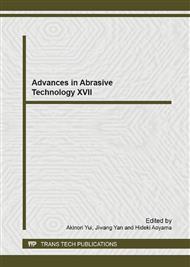p.350
p.355
p.361
p.367
p.373
p.377
p.383
p.389
p.393
A Study of Ultrasonically Added High Speed Turning for Stainless Steel - The Effects of Ultrasonic Oscillating Direction and Chip Breaker Shape and Material
Abstract:
Ultrasonic cutting is a technique that can improve machinability such as fine surface, reduce tool worn out and etc. To improve processing speed of ultrasonic cutting is difficult due to the effects of tool oscillation are invalidated when cutting speed exceeds maximum tool oscillating velocity. In previous report, high speed principal direction ultrasonic turning without thrust direction vibration experiments for stainless steel were carried out to improve processing speed and products quality. In ultrasonic turning, tool worn out and built up edge generation were reduced compare with ordinary turning. Fine surface without thrust direction periodically cut marks were obtained in ultrasonic turning experiments. In this study, the effects of chip breaker shape and insert material were investigated. Surface roughness, chip worn out and built up edge generation were investigated in this study.
Info:
Periodical:
Pages:
373-376
Citation:
Online since:
September 2014
Authors:
Price:
Сopyright:
© 2014 Trans Tech Publications Ltd. All Rights Reserved
Share:
Citation:


